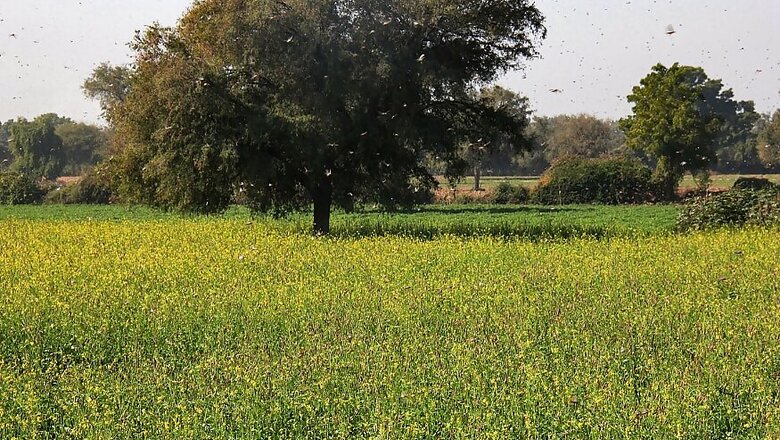
views
Ahmedabad: The Gujarat government on Thursday promised compensation for farmers in Banaskantha district and other areas of North Gujarat which are facing a massive locust attack over the last two weeks.
Huge swarms of locusts, arriving from desert areas of Pakistan, descended in Banaskantha, Mehsana, Kutch, Patan and Sabarkantha districts over the last few days and attacked crops such as mustard, castor, fennel, cumin, cotton, potato, wheat and jatropha, officials said.
In Banaskantha, crops over 5,000 hectares have been damaged, said a senior official. The Union government has sent 11 teams to help the state administration tackle the menace.
"We have formed 27 teams, comprising central and state government officials, to keep a watch on the movement of swarms and to spray pesticide. Till now we have sprayed pesticide over 1,815 hectares in Banaskantha," Chief Minister Vijay Rupani told reporters.
The state government would conduct a survey and compensate the affected farmers, he assured. The state government is also exploring the possibility of using drones to spray pesticide, he said.
Union Minister of State for Agriculture Purushottam Rupala said that the Central government will provide all possible help to Gujarat to tackle
the problem of locusts.
"To tackle the menace, the centre has sent its team to Gujarat and the problem is expected to be solved in 6 to 7 days," Rupala told PTI
Farmers have been directed to use various measures to keep off the swarms, including burning tyres, playing drums and clanging metal objects, installing table fans in the fields and even playing music loudly, an agriculture department official said.
Locusts were first seen in Suigam, Danta, Deesa, Palanpur and Lakhni tehsils of Banaskantha last week. From there they moved to Satlasana tehsil in Mehsana district.
"They entered Gujarat from the desert areas of Pakistan. This is the second time in a month that locusts have invaded the fields in north Gujarat," Deputy Chief Minister Nitin Patel said earlier.
Local farmers said they were witnessing the phenomenon after almost a decade. Punamchand Parmar, Additional Chief Secretary in the state Agriculture department, said the locusts have affected crops over 5,000 hectares in Banaskantha district.
A few days ago a huge swarm, spread across 30 to 35 square kilometers, descended in Tharad tehsil and devoured mustard, castor, funnel and wheat crops, he said, adding that locusts are still present in neighboring areas of Jalore district in Rajasthan and in Tharparkar desert of Pakistan.
"We have deployed 45 teams in Tharad where a large swarm descended two days ago," he told reporters in Gandhinagar.
Of the 11 tehsils of Banaskantha where locusts were seen, Suigam, Danta, Tharad and Vav are the worst-hit.
"Though we have been able to kill around 25 per cent of locusts so far, it will take another four days for the teams to completely eliminate them. Looking at the wind patterns, it seems the locust swarms in Jalore and Tharparkar may not enter Gujarat," Parmar added.
Parbat Patel, local MP, said the attack was unprecedented. "We have never seen such a large number of locusts. The swarms have caused large-scale destruction.
Government is trying to ensure that they do not invade new areas," he said. Gujarat Congress chief Amit Chavda and Leader of Opposition in the Assembly Paresh Dhanani said the state government's measures to contain the attack were inadequate.
The government should have used aircraft to spray pesticides, they said. However, agriculture minister R C Faldu said this method could be dangerous for animals which graze in open fields.



















Comments
0 comment